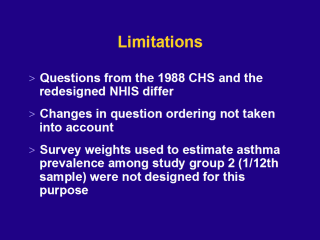| front |1 |2 |3 |4 |5 |6 |7 |8 |9 |10 |11 |12 |13 |14 |15 |16 |17 |18 |19 |20 |21 |review |
 |
There are
limitations that must be considered when interpreting these findings. First,
the asthma questions from the 1988 CHS that we used to approximate the
estimates from the redesigned NHIS are different from the redesigned NHIS
asthma questions. The post-1997 estimates are based on a stricter case
definition than the 1988 CHS questions. Although the CHS questions ask if a
child ever had asthma and, if so, if he or she had asthma in the past 12
months, the redesigned question requires a diagnosis by a medical
professional and an attack or episode of asthma in the past 12 months.
Therefore, our estimate of the impact of the 1997 redesign on asthma
estimates is likely to be conservative. Second, the NHIS questionnaire was completely redesigned in 1997, including structure and order of the questions. We were not able to estimate the impact of these changes. Third, it was necessary to use the survey weights from 1988 to estimate national prevalence for study group 2 (the 1/12 sample). However, the weights were not designed to be used in this way, and bias may have been introduced into our analysis. Despite the limitations, examining responses for the 1988 NHIS child participants shows that the redesigned NHIS is capturing a different aspect of asthma and therefore produces lower estimates than the previous questionnaire for a given "background" asthma prevalence in the population. Directly comparing pre- and post-redesign estimates without taking the impact of the redesign into account will lead to an erroneous conclusion that childhood asthma prevalence has recently declined. When the change in the questions used to estimate asthma prevalence is taken into account, asthma prevalence in 1997-2000 appears to have remained at mid-1990s levels. |